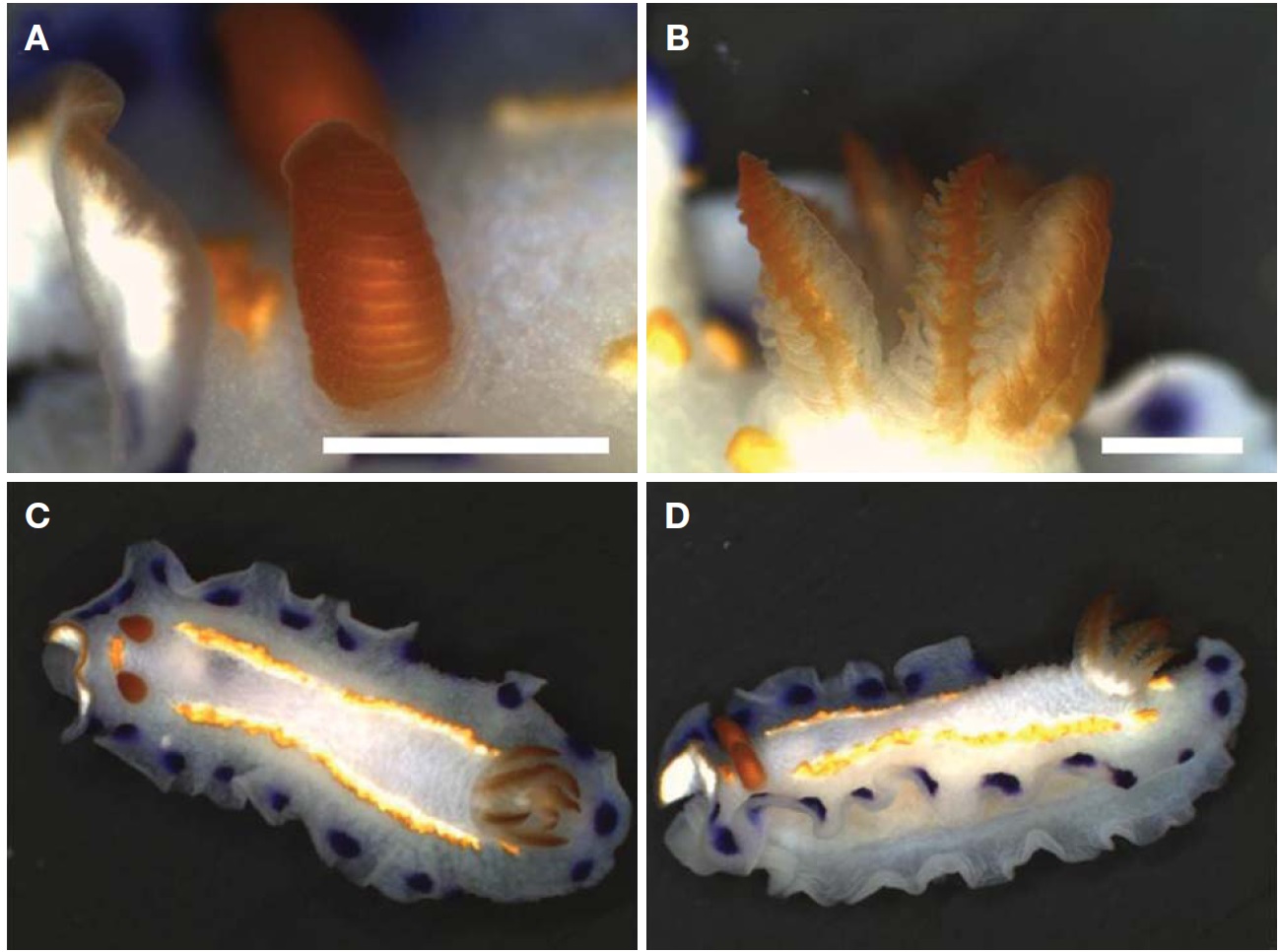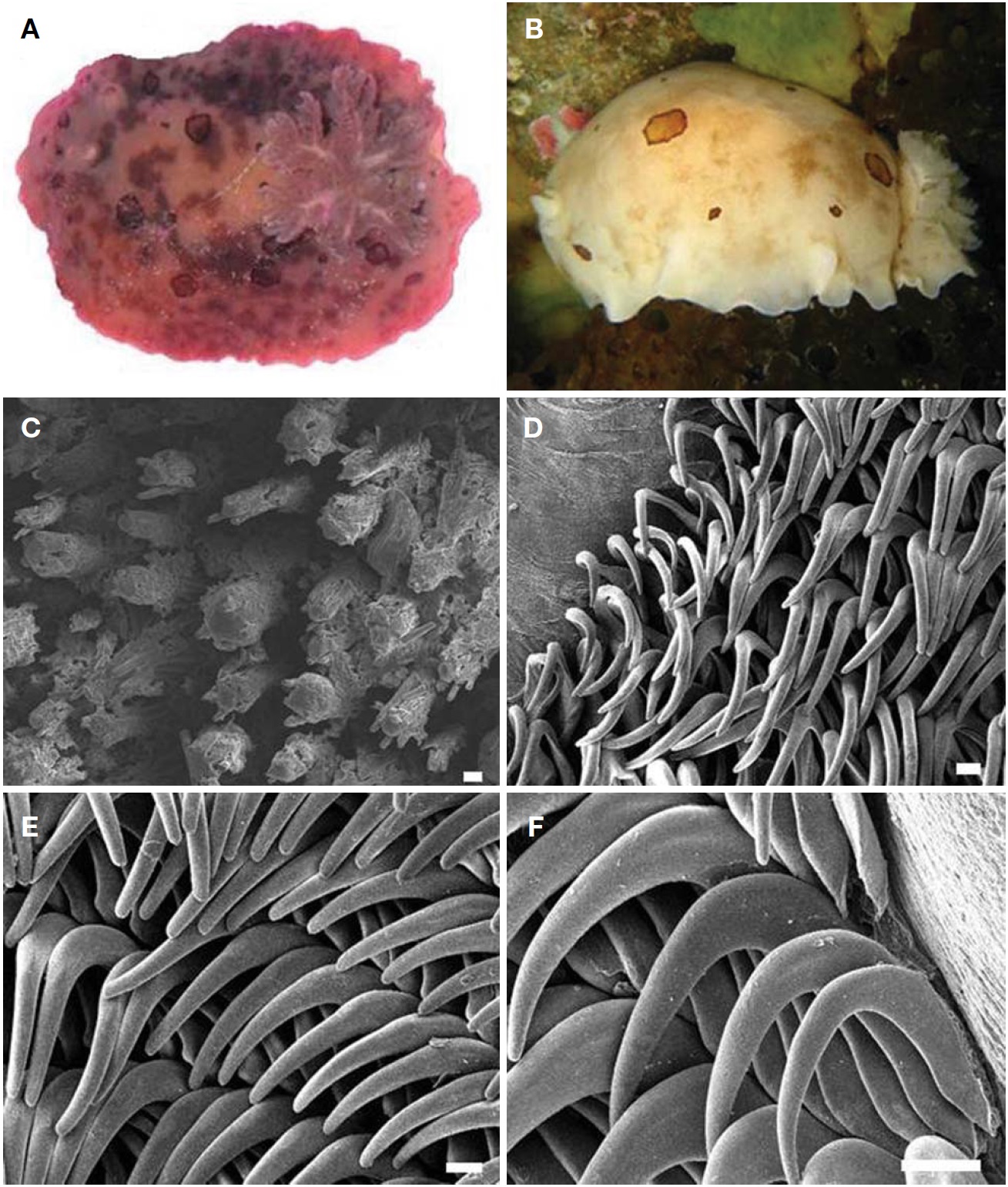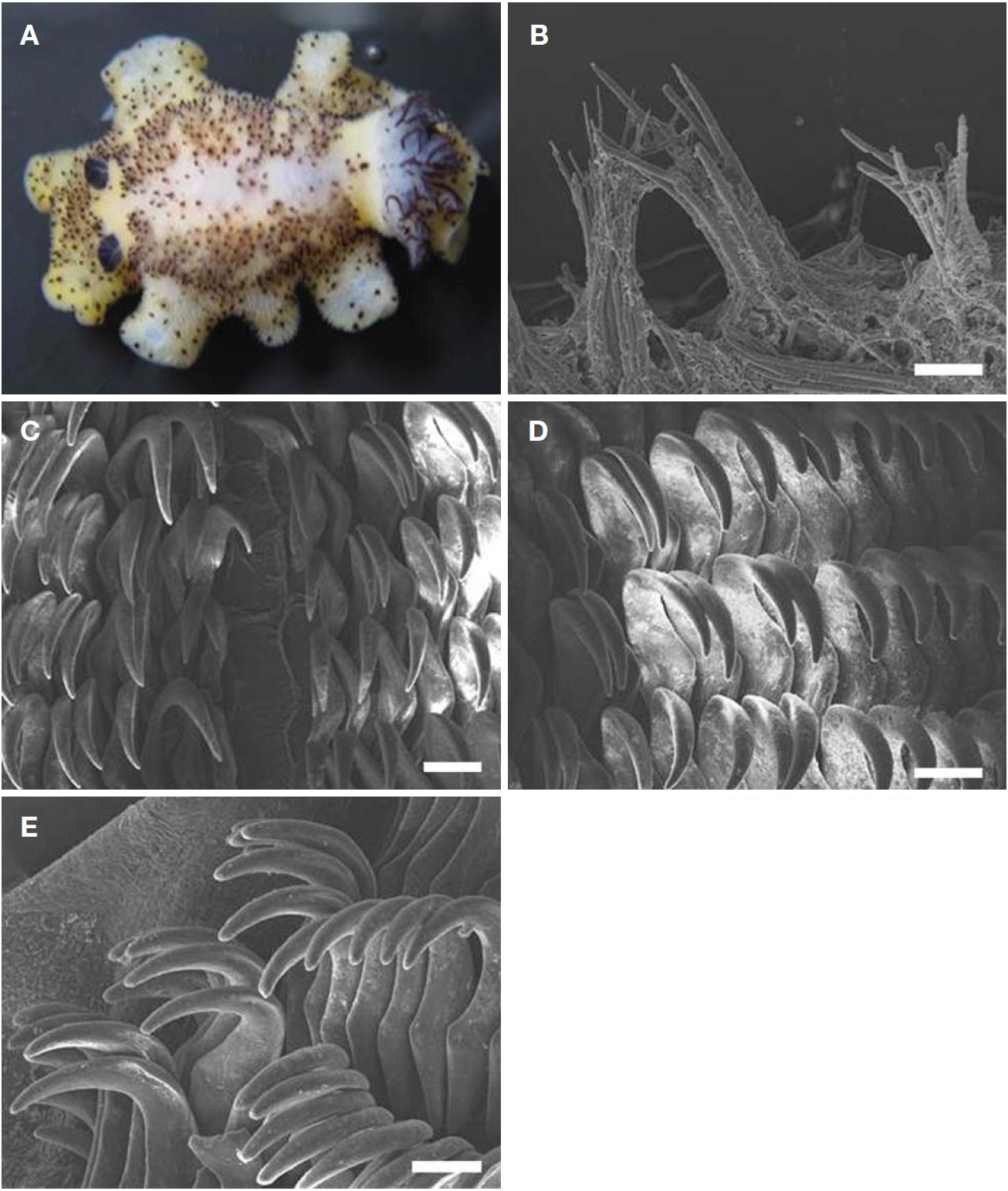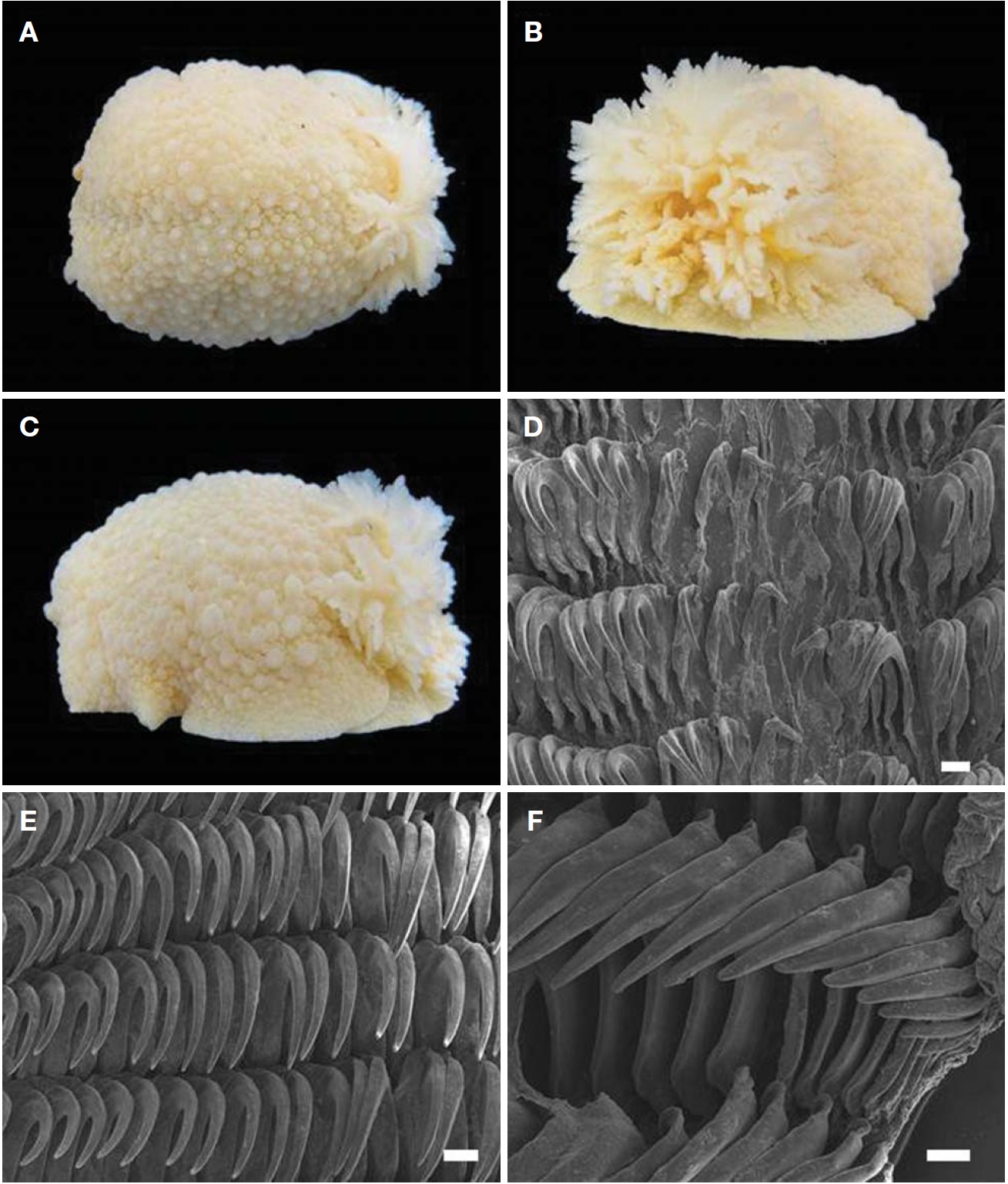



The Nudibranchia is a large member of marine mollusks (Gosliner et al., 2008). Species of the superfamily Doridoidea in the nudibranchs are characterized by wide mantle skirt (Debelius and Kuiter, 2007). There were only 12 species recorded from Doridoidea in Korean waters (Choe, 1992; Lee, 1993; Choe and Lee, 1994; Lee and Min, 2002; Choi, 2003):
Specimens were collected by scuba diving in the Korean coast. Materials were fixed in 10% neutral buffered formalin or 97% ethanol after treatment with a 8% MgCl2 solution. The materials were observed and dissected with a stereoscopic microscope (Olympus SZ-61 with FuzhouTucsen TCA-3, Tokyo, Japan). Body lengths of most specimens examined were measured from the front of the rhinophores to the tip of the metapodium. For examining radulae, the buccal mass was dissolved in 10% potassium hydroxide solution until the radulae were isolated. The radulae were dried, mounted on stubs, coated with gold, and observed by a scanning electron microscope (HITACHI S-4300, Tokyo, Japan) with accelerating voltage of 10 kV. The specimens examined in this study were deposited in the National Institute of Biological Resources (NIBR), Incheon, Korea and Sangmyung University, Seoul, Korea. NIBR specimen numbers are indicated in parentheses beside the specimens.
Phylum Mollusca Linnaeus, 1758
Class Gastropoda Cuvier, 1795
Order Nudibranchia Cuvier, 1817
Superfamily Doridoidea Rafinesque, 1815
Diagnosis. Mostly oval. Head distinct form their body. Gills retractile into a gill pocket. Mantle skirt wide (Debelius and Kuiter, 2007).
Family Chromodorididae Bergh, 1891
Genus Thorunna Bergh, 1878
Material examined. Korea: 2 individuals, Gangwon-do:
Gangneung-si, Anhyeon-dong, 11 Nov 2011; 8 individuals, Goseong-gun, Toseong-myeon, Bongpo-ri, 26 Aug 2012 (KOSPIV00001651-2, KOSPGR0000234416, KOSPGR00 00234421-5).
Diagnosis. Body (length 18-22 mm, width 6-11 mm) elongate, translucent milky white in ground color. Rhinophores lamellate, deep orange in color. Gills seven to eight of simple unipinnate, translucent with deep orange edge (Fig. 1A, B). Mantle widely stretches to cover up the foot. Submarginal band of purple spots along edge of mantle. Two bright yellow striped lines from behind rhinophores to around gills. A yellow spot in front of rhinophores (Fig. 1C, D).
Distribution. Korea, Japan, Thailand, Hong Kong, Indonesia, Australia, Vanuatu.
Remarks. Rudman (1990) indicated that Australian
Family Discodorididae Bergh, 1891
Genus Diaulula Bergh, 1878
Material examined. Korea: 6 individuals, Gangwon-do: Yangyang-gun, Sonyang-myeon, Susan-ri, 1 March 2011; 2 individuals, Gangneung-si, Anhyeon-dong, 10 May 2011; 2 individuals, Yangyang-gun, Hyeonbuk-myeon, Gisamun-ri, 5 Aug 2012; 1 individual, Gyeongsangbuk-do: Uljin-gun, Wonnam-myeon, Deoksin-ri, 26 Aug 2012 (KOSPIV00001 65225).
Diagnosis. Body (length 35-70 mm, width 23-53 mm) ovate and convex. Body white, translucent brown and chocolate brown. Several irregular and various sizes of patches of dark brown rings scattered on dorsum (Fig. 2A, B). Rhinophores elongate with 10 lamellae. Gills with 6 tripinnate brachial leaves. Rhinophores and gills same color as body. Dorsum entirely covered with caryophyllidia about 100 μm in length (Fig. 2C), with velvety appearance. The innermost lateral teeth narrow and elongate (Fig. 2D). Mid lateral teeth longer and thicker than inner lateral teeth (Fig. 2E). Outermost lateral teeth falcate with blunt end (Fig. 2F).
Distribution. Korea, Japan, Baja California to Alaska.
Remarks. This species shows a variety of color. Most specimens examined in the previous works are white to pale brown yellow and chocolate brown (Baba, 1957; McDonald, 1983; Okutani, 2000; Valdes and Gosliner, 2001; Debelius and Kuiter, 2007). Specimens examined in the present study showed both translucent white, translucent brown and chocolate brown.
It was suggested that specimens collected from bay areas are normally darker than those from open coastal waters (McDonald, 1983). Specimens collected inside the harbor at Susan-ri showed chocolate brown, with more irregular patches than rings, while specimens obtained outside the harbor of the same area were a bright brown, with more rings than patches (Fig. 2A, B). This may indicate that different habitat conditions produced two variations of body color within this species.
Genus Jorunna Bergh, 1876
Material examined. Korea: 2 individuals, Jeollanam-do, Sinan-gun, Heuksan-myeon, Gageodo-ri, 9 Oct 2012 (KOS PIV0000165260).
Diagnosis. Body (length 27-40 mm, width 13-21 mm) elongate. Body color dark yellow to brown and lighter around rhinophores and gills. Center of dorsum opaque white (Fig. 3A). Long caryophyllidia, about 80-210 μm in length (Fig. 3B), on dorsum show different shape and size. Longer caryophyllidia dark brown, showing dark spots appearance. Rhinophores elongate with 15 lamellae. Gills with 6 bipinnate brachial leaves. Rhinophores and gills dark brown to black. The innermost lateral teeth narrow and elongate (Fig. 3C). Mid lateral teeth little bigger than inner lateral teeth (Fig. 3D). Outermost lateral teeth falcate with blunted end (Fig. 3E).
Distribution. Korea, Japan, Palau, Philippines, Indonesia, Papua New Guinea, western Pacific of Australia, South Africa, Seychells, Tanzania.
Family Dorididae Rafinesque, 1815
Genus Doris Linnaeus, 1758
Material examined. Korea: 6 individuals, Gyeongsangbukdo: Uljin-gun, Uljin-eup, Yeonji-ri, 25 Aug 2012; 3 individuals, Gangwon-do: Gangneung-si, Yeongok-myeon, Yeongjin- ri, 19 May 2012; 5 individuals, Gangneung-si, Namhangjin- dong, 9 Sep 2012 (KOSPIV0000165264).
Diagnosis. Body very large and distinctive (length 80-205 mm, width 43-110 mm). Body color white to yellow (Fig. 4A). Rhinophores lamellate. Gills with 7 tripinnate brachial leaves like fluff (Fig. 4B). Rhinophores and gills same color as the body. Dorsum covered with rounded and simple tubercles varying size and shape. Tubercle decrease in size from
top to edge of mantle (Fig. 4C). Innermost lateral teeth short and narrow (Fig. 4D). Mid lateral teeth gradually tapered to tip (Fig. 4E). Outermost lateral teeth falcate (Fig. 4F).
Distribution. Korea, Bering Sea, Alaska, California
Remarks. This species is the biggest nudibranch species in Korea currently known. Body color of the species was reported as white in more materials, and as yellow in rare case (McDonald, 1983; Debelius and Kuiter, 2007). However, most specimens examined here were almost dark yellow, and were white in rare samples.



